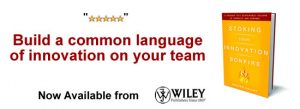Managing the Unknowable, Unforecastable and Unplannable
This Is Not What They Teach In Business Schools

by Idris Mootee
I don’t think anyone will disagree with me when I say that the future is unknowable and no one can accurately predict the future with any level of confidence. I remember when we were working to support the global launch of Lisa and had no idea whether it would take off or not. It was a long shot marketing the Lisa to corporate IT folks to convince them to switch to Apple back then, and many are still not convinced today. Does it mean we should just give up managing the future? What about the future of Kindle? Their predicted sales are pegged at $1.2 Billion and analysts think they will become the iPod of ebooks, but how likely is it that this will happen?
For any innovative product or service, there are so many unknowns and any forecast seems to be an impractical exercise. Strategic planning is often used to describe operational planning. Real strategic planning is about planning for the future. Do you think that some planning exercise can effectively forecast future sales of innovative new products without seeing what the competitive landscape will look like in the future? To do strategic planning, let’s first admit that there is no way to know what the long-term future looks like and that any vision you have may not be relevant at all.

So how do you manage the unknowable and unforecastable? But at the same time, make many long-term decisions? This is the big paradox of organizations and management. We need to organize in a way to coordinate many parts of the organization to function and to create some stability in the day-to-day running of different units. The art is for existing structures and processes to co-exist with the flexibly (and sometimes instability) to adapt to changes. Some believe senior executives or the board should set the direction of the company and control all strategic directions and resource allocation. In fact, the better approach is to set the overall directions and then create favorable conditions and flexible architectures to support learning and innovation by middle management.

A friend of mine (a senior exec with a bank) uses the analogy that no matter how smart a person is or even if the person doesn’t sleep, he or she can never out-think or out-innovate tens of thousand middle managers if each only spend 5 minutes a day thinking about new ideas to improve performance or new ways to serve customers better. How true?
It is far more important to expose senior and middle manages to new mental models, unarticulated customer needs and future industry scenarios that together form new maps and perspectives. This way you can power up their collective imagination and stimulate creative dialogues.

I’ve seen so many flaws in so called ‘strategic plans’ and many fail to demonstrate (let alone guarantee) the millions of dollars in new revenue or savings they promise. It is easy to wave the words ‘quality’, ‘growth’ or ‘innovation’ about casually like a magic wand to justify investments, without bothering to define what the possible futures are. I will write more in the next few weeks on how to avoid the mistakes of ‘strategic planning’. Strategic planning that’s rooted in the assumption that the past dictates the future, is merely a limit of the planner and not the plan.

Anyone who is familiar with strategy frameworks like the Balanced Scorecard/Strategy Map methodology from Kaplan and Norton knows the importance of Leading Indicators: Metrics that are forward-focused rather than simply stating past performance. Leading Indicators are sometimes disguised as ‘Weak Signals’ and that’s why it is more difficult to interpret.
I believe strategic innovation and strategic planning are two very different (not mutually exclusive) approaches that people mix up. Strategic innovation is a process to discover new value through new ideas while the strategic planning process is based on what happened and what to respond to. Without something happening, planners cannot plan further. In most cases, the strategic planner assumes business as usual. It is hard to find business as usual today. And often they underestimate the magnitude of change and disruptions. Their job is not to read and interpret ‘weak signals’. That’s why innovation, strategy and operations are three different functions and require very different skill sets.
“Looking back, it is clearer to me now that these plans – for all their seemingly tight, logical connections between mission, belief, goals, actions, responsibilities, and evaluation – were like beautiful but badly leaking boats.”
– Mike Schmoker
 Idris Mootee is the CEO of idea couture, a strategic innovation and experience design firm. He is the author of four books, tens of published articles, and a frequent speaker at business conferences and executive retreats.
Idris Mootee is the CEO of idea couture, a strategic innovation and experience design firm. He is the author of four books, tens of published articles, and a frequent speaker at business conferences and executive retreats.
NEVER MISS ANOTHER NEWSLETTER!
LATEST BLOGS
What happened to smart advertising?
For a television advertisement to be effective, do you need to lay out everything for the viewer and make it obvious? Or, is an advertisement more memorable if you let the viewer connect the dots themselves? Here are two examples of television advertisements that promote the product in a slightly more intellectual/emotional way that promotes engagement and curiousity:
Read MoreInvention versus Innovation
Continuous innovation requires that innovation is placed at the center of the organization and that all parts of the organization are changed to support it. To effectively place innovation at the center of the organization, people must know what innovation is, what it looks like in their organization, and how they can contribute. Most people easily confuse invention with innovation, and wrongly chase invention in the name of innovation.
Read More


